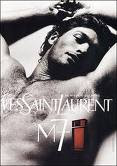Firstly, when focusing on this print advertisement for Calvin Klein Jeans, the idea of the new man and the female gaze can be applied. Again, similar to the television commercial for Dolce and Gabbana, it is the idea of the ‘new man’ that is the main focus of the advertisement and the woman’s body appears covered up and in this case her once objective body is cropped out of the entire advertisement. However, what is most interesting and emphasises Phillip Patterson statement in his essay Stereotypical Images of Men in Advertising that there is ‘more of the ideal male body in the ad than the product being advertised’ (Lester, 1996), is the fact that the product, being the Calvin Klein Jeans are hardly in the shot and almost merged in with the dark background in comparison to the amount of male flesh that the consumer of the advertisement are faced with. This could enable the female gaze theory to be applied as it could be argued that he is just another pretty image that all women want to fixate on whilst flicking through Cosmopolitan or Vogue which could trigger them to buy Calvin Klein Jeans for themselves or their partner in order to get the same attention as the male in the advertisement.
Secondly, like the Dolce and Gabbana commercial, the male model appears to be a tall, dark and handsome, toned and tanned young man. It becomes quite obvious that this ‘type’ of male has to be used in order to catch the female gaze leading the idea of the ‘new man’ to almost become a stereotype just like the blonde and busty female who is mainly the recipient of the male gaze. It could be argued that the media has drilled this idea of a perfect man into the heads of the consumers as this flawless image of the male body is seen in numerous media texts which are reflected in the range of media texts that are apparent in this blog.
Thirdly, the fact that the woman is dominating the male in this sexual advertisement could suggest to the female consumer that if her man buys Calvin Klein Jeans he will be as desirable as the model in the advert. In addition to this, the dominance of the female could be emphasising the idea of ‘the new man’ as he appears to be in a vulnerable state and the idea of role reversal could be applied. It is the male that in the past has been dominant of the woman, however it could be argued that the male has been feminised in this advert as he appears to be pinned down by the woman in a sexual manner. On the other hand, when focusing on the male consumer, he may think that if he buys these jeans it will be easy to get a woman which is the focus of this advertisement emphasising the fact that the male body is used in order to sell the initial product, however, this process portrays his body as the product which takes the attention away from the actual product the company is wanting to sell. In addition to this, the similarities are constant in terms of the Dolce and Gabbana commercial. It could be argued that the man is not looking at the woman and is in fact admiring his own body in his Calvin Klein jeans, suggesting again that the male is the main focus of the advertisement rather than the woman and that the woman is only part of the advertisement to emphasise the sexual desire of the female gazer and to almost create a starting point for the fantasising consumers.














